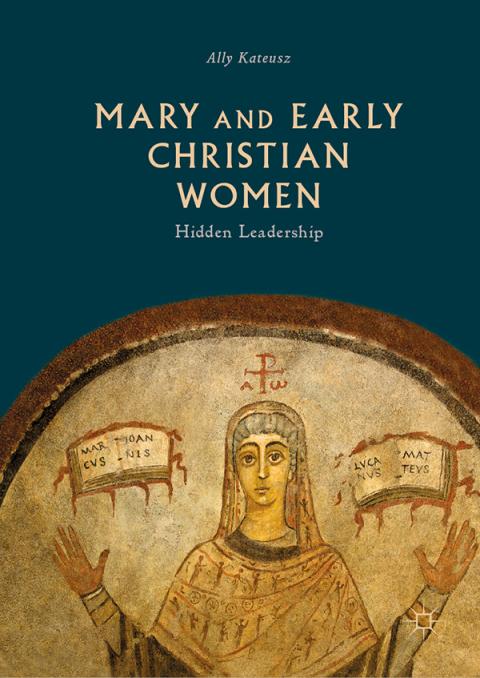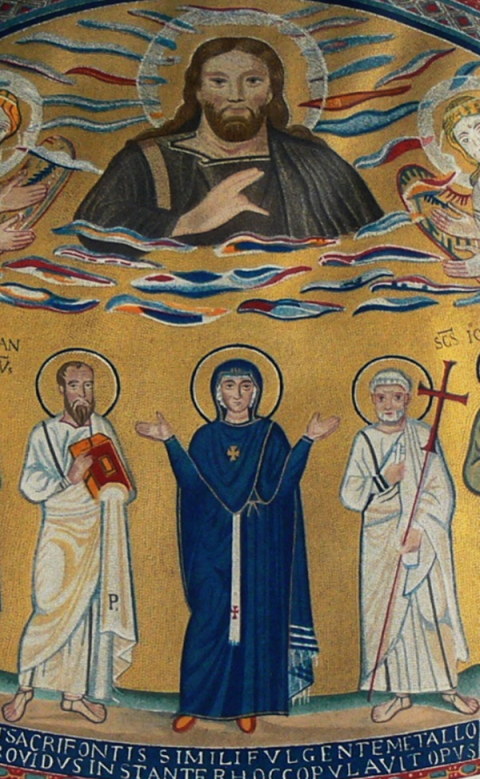
A stone sarcophagus front from the Hagia Sophia in Constantinople, circa A.D. 430, at the Instanbul Archaeological Museum, showing a male and a female figure standing on either side of the altar. (Courtesy of Ally Kateusz/Wijngaards Institute of Catholic Research)
New research recently unveiled in Rome suggests women had a greater role in the early church's ministries and liturgies than previously thought and were present at church altars as deacons, priests and even bishops.
Ally Kateusz, research associate at the Wijngaards Institute for Catholic Research, presented her findings July 2 to the International Society of Biblical Literature, drawing on iconography from ancient Christian art.
A specialist in the history of late antiquity, she has taught at both Webster University and the University of Missouri-Kansas City. She told the conference, which was held at the Pontifical Gregorian University in Rome, that three of the earliest surviving images of Christians worshipping at church altars show women in official liturgical roles.
One of the artifacts she bases her findings on is an ivory reliquary box dating from around A.D. 430 that depicts a man and a woman standing on either side of an altar, each raising a chalice. The altar is that of Old St. Peter's Basilica in Rome. The gesture of raising a chalice is recognized as a liturgical act performed by priests.
Two other artifacts also depict women at altars: One is a sixth century ivory pyx of the Church of the Holy Sepulcher in Jerusalem, and the other is a stone sarcophagus front from the Hagia Sophia in Constantinople, which dates from around A.D. 430 and shows a male and a female figure standing on either side of the altar, holding their arms up in the orans pose.

"Pyx with the Women at Christ's Tomb," ivory pyx, circa A.D. 500s, made in Eastern Mediterranean (Metropolitan Museum of Art)
Kateusz believes that the images are significant because they show women and men in parallel roles, their bodies and gestures mirroring one another, and she suggests that this parallelism is indicative of their equality in their liturgical roles.
"If the sculptors had portrayed only men at these church altars, everyone would assume that they had important liturgical roles," she said.
According to Kateusz, author of Mary and Early Christian Women: Hidden Leadership, the artworks "illustrate that early Christian women routinely performed as clergy in orthodox churches."
"The art speaks for itself because women are seen at the church altar in three of the most important churches in Christendom," she told NCR. She believes it is likely that women's participation in liturgies and the Eucharist in the early church was routine.
Virtually no liturgical manuscripts survived from the first seven centuries of Christianity in relation to ordination, lending to a long gap in the historical record. The oldest manuscript describing ordination in the Roman rite, the Ordo Romano, dates from the ninth century, centuries after these three artifacts.

"Pyx with the Women at Christ's Tomb," ivory pyx, circa A.D. 500s, made in Eastern Mediterranean (Metropolitan Museum of Art)
"Later scribes easily censored texts that would have originally described women's ordination. But these artifacts survived because they were buried. They were dug up in the 20th century," explained Kateusz. The artifacts provide "precious windows through which we can see the early Christian liturgy as it was once performed," she said, pointing out that there is no early Christian art where only men are depicted at the church altar.
But not everyone is convinced that these female figures were priests.
"The woman raising a chalice would be consistent with the deacon's role at the time of the showing in the Mass, and there is documentation that women deacons participated in the Mass in this manner," Phyllis Zagano, adjunct professor of religion at Hofstra University in New York and a member of Pope Francis' commission on women and the diaconate, told NCR. Zagano also highlighted that there are no extant ordination ceremonies for women as priests, but there are many for women as deacons.

The book cover to "Mary and Early Christian Women: Hidden Leadership" by Ally Kateusz, features a fresco from the Catacomb of San Gennaro in Naples, Italy, that was covered with a marble plaque until 1977, and later restored in 2011 ((Courtesy of Ally Kateusz/Wijngaards Institute of Catholic Research)
Interpreting the depiction of the lifting of the chalice on the fifth century ivory reliquary box as exemplifying priesthood rather than the diaconate is not clear cut, Kateusz acknowledged.
"In most cases we might assume they were two priests or two bishops presiding together at the altar," she said. "Yet a writing, known as the Didascalia Apostolorum, describes early Christian communities in the East where a pair of male and female deacons supervised the offerings. The male deacon symbolized Christ while the female deacon symbolized Holy Spirit, who was feminine gender everywhere Aramaic was spoken, and this pair ranked above the presbyters, who merely represented the apostles."
Other female figures depicted in liturgical roles in the artifacts could be women deacons.
"The portrayal of some of the men and women in Old St. Peter's altar area seems consistent with the role of deacons," Kateusz said. "The two women seen carrying censers of incense at the altar in the Church of the Holy Sepulcher in Jerusalem is clearly consistent with the role of deacons."
In Rome, Kateusz led a group to see a mosaic at San Venantius Chapel in the Lateran Baptistery which depicts Mary wearing what appears to be a pallium, a symbol of episcopal authority given to new bishops. According to Miriam Duignan of the Wijngaards Institute for Catholic Research, who was part of the group, the Holy Office decreed in 1916 that all images depicting Mary in priestly vestments were to be banned and this mosaic was obscured by a massive altar piece. Most of the documented red tesserae comprising the cross on Mary's pallium were removed. The mosaic shows Mary's arms raised as if performing the Eucharist.

Altar apse mosaic, circa A.D. 650, San Venantius Chapel, Lateran Baptistery; an 1890s painting of the mosaic by Giovanni Battista de Rossi, that depicts Mary wearing an episcopal pallium with a red cross. (Courtesy of Ally Kateusz/Wijngaards Institute of Catholic Research)
"The episcopal pallium was not seen on anyone in art until 550. This is 650. It is only ever given to someone considered a bishop. Pope Theodore commissioned this mosaic including the bishop's pallium. It is a symbolic way of saying Mary was a church leader," Duignan said.
Some experts believe that women depicted with a pallium are abbesses. However, Kateusz refers to Russian art historian Alexei Lidov's research. He believes this seventh century mosaic of Mary with the pallium is a symbol of her priesthood, comparing it with an 11th century wall painting in Old St. Clement Basilica in Rome, that depicts Pope Clement with his arms raised wearing the same pallium while performing the Eucharist at an altar table.
"Why would we interpret the episcopal pallium seen on Mary standing with her arms raised above the altar in the Lateran Baptistery just half a mile away differently?" Kateusz asked.
Gary Macy, John Nobili SJ, Professor of Theology at Santa Clara University, said the question of ordaining women to the priesthood has been closed by the Vatican, but that should not, and will not, stop historians from analyzing new material and texts that may portray women as either deacons or priests.
Speaking to NCR, he agreed that Kateusz's female figures could be deacons or priests.
"Women deacons also had the pallium," he explained, shown by the 10th century ordination rite for a deaconess. Macy, author of The Hidden History of Women's Ordination: Female Clergy in the Medieval West, acknowledged that the fifth century ivory reliquary box depicting a female figure lifting a chalice could suggest priesthood. "It is a possibility," he said, but there are other Christian artifacts that depict a woman lifting a chalice. "St. Barbara, for example, is traditionally portrayed as holding a chalice."
As to whether a woman with a pallium is a bishop or an abbess, Macy told NCR, "Some abbesses acted as de facto bishops. Mary could be depicted as a deacon because she 'made the word present' just as the deacon does when the Gospel is read."
"The most obvious interpretation of these artifacts is that women held liturgical roles in the early church," Macy said. "For centuries, it was just presumed that women did not lead the liturgy or perform certain liturgical functions in Christianity. That presumption is no longer held, so one looks at the remains of the past without that presumption."
Macy does not believe, however, that the Vatican tried to hide the evidence of women in liturgical roles.
"Sometimes attempts have been made to change the texts or portrayals, but I suspect these are individual acts, not some concerted plan," he said.
But Duignan believes the Vatican has hidden evidence and this new research is unlikely to find too many supporters even today.
"The Vatican will undoubtedly be reluctant to engage with these findings because they have led a campaign to exclude women via the argument of tradition," she said. "But for most Catholics, the research will confirm what they suspected all along — that the ban on female clergy has always been about the silencing and suppression of women and never about true tradition."
[Sarah Mac Donald is a freelance journalist based in Dublin.]
Advertisement






